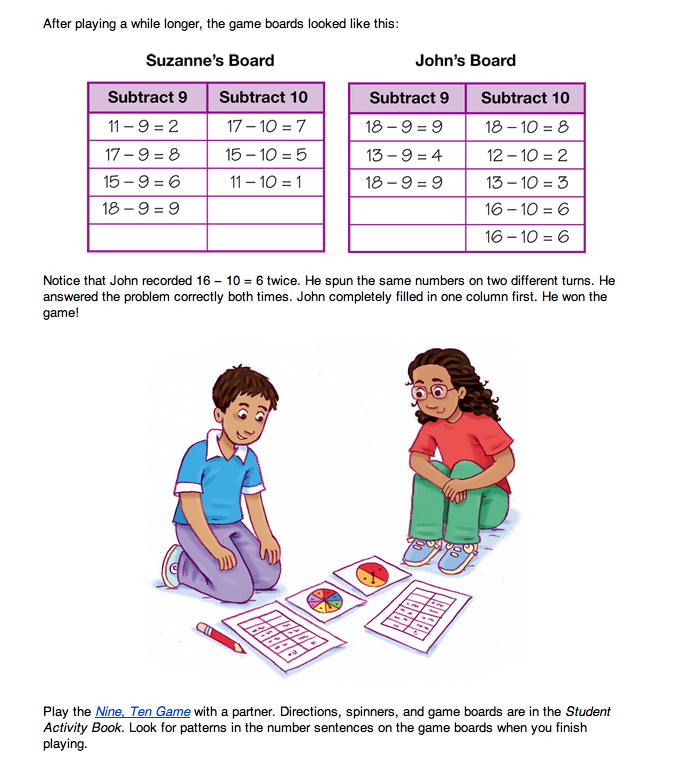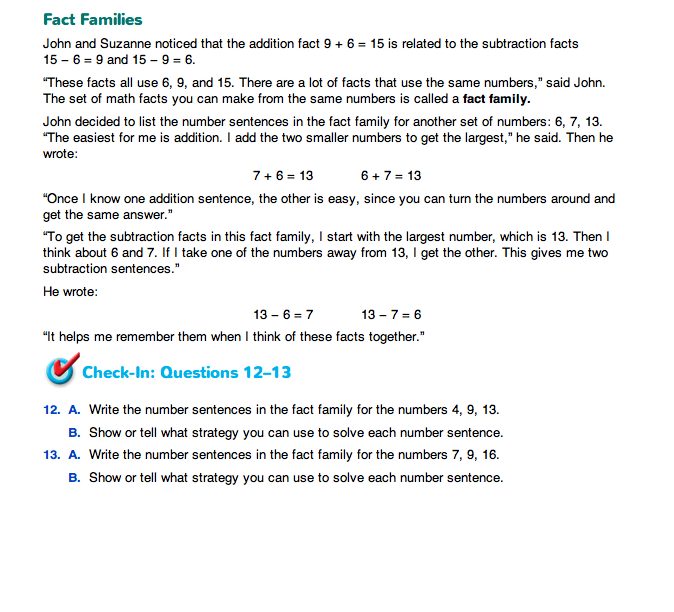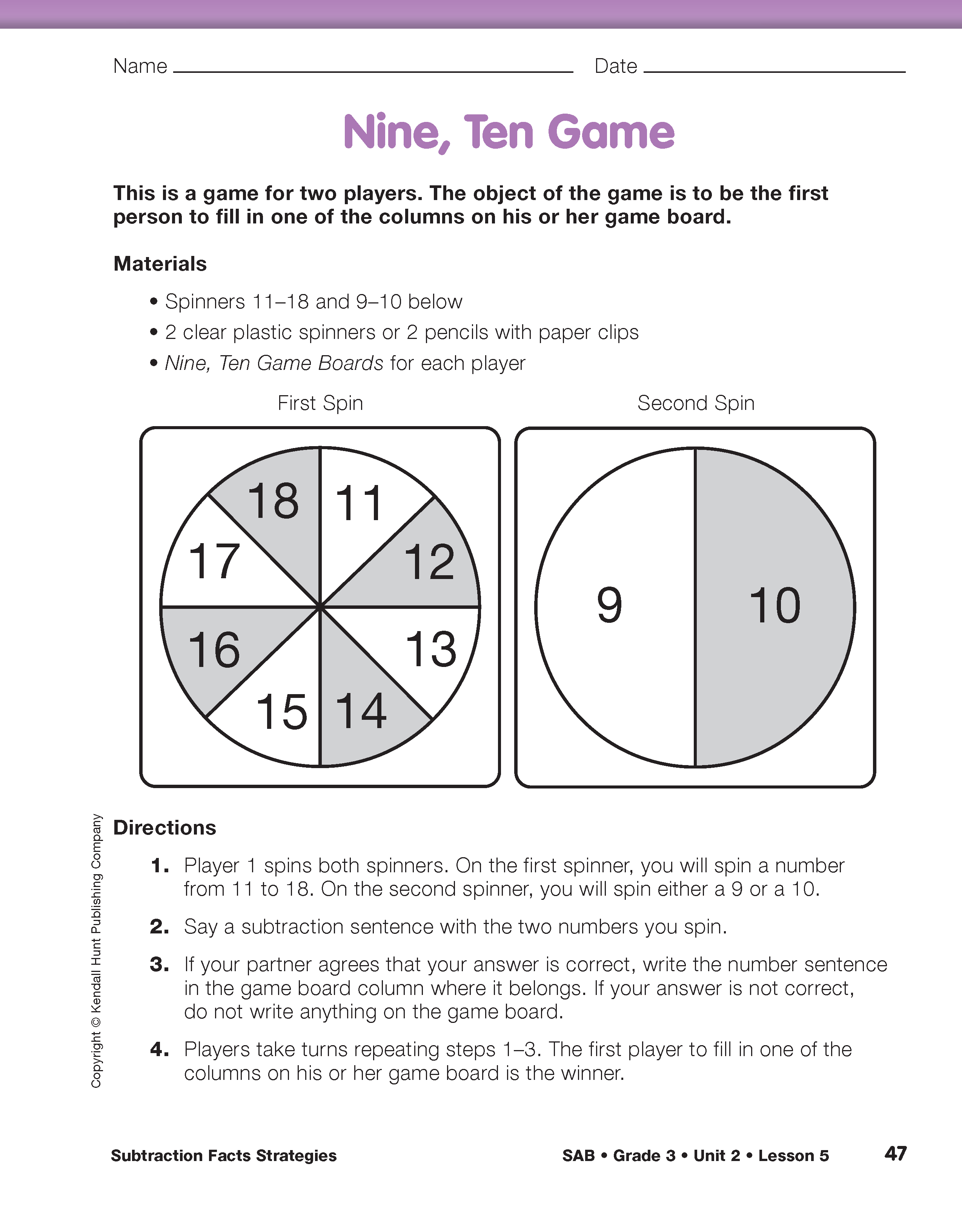Play Nine, Ten. Introduce the Nine, Ten Game by reading the Suzanne and John's Sample Game section in the Student Guide. The sample game shows how students record the number sentences on their game boards. Students practice subtracting nine and ten while playing the Nine, Ten Game. The game encourages the use of the strategy using tens.
Read the directions aloud for Nine, Ten Game in the Student Activity Book while students follow along. Demonstrate how to use a spinner, if needed.
As students play the game, circulate and listen as they solve the problems. If students are having trouble, encourage them to use strategies to help them write correct number sentences.
Also, as they fill in their columns, ask:
- Do you see any patterns on the game board? (Possible responses: Each difference in the “Subtract 10” column is the same as the ones digit of the first number in the sentence. Each difference in the “Subtract 9” column is one more than the ones digit of the first number in the sentence.)
Then ask students to look back over the number sentences written on their game boards. Ask them to think about how they solved those subtraction problems.
- Which problems did you solve by using ten? Which by thinking addition? Which do you feel you “just knew”?
Fact Families. This lesson highlights two strategies, using tens and thinking addition, to solve subtraction problems. As students become familiar with more facts, they may start to feel that they “just know” some of them. For example, they probably “just know” that 5 − 1 = 4. They can increase the number of facts they “just know” if they think of them in fact families.
Ask students to turn to the Fact Families section of the Student Guide. Read the short vignette together and then use the following questions to discuss fact families.
- How are these numbers related: 8, 7, 15? (They are all in the same fact family. We can use them to make 2 addition fact sentences and 2 subtraction fact sentences.)
- Look at the sums and differences in the addition and subtraction facts for the numbers 8, 7, and 15. What patterns do you notice? (The sum is 15 in both addition number sentences; 7 + 8 = 15 and 8 + 7 = 15, and in the subtraction number sentences the difference is either 7 or 8. Only the three numbers in the fact family are ever used in the number sentences.)
- How does knowing 8 + 7 = 15 help you solve 15 − 8? (8 + 7 = 15 is related to 15 − 8. Since 8 + 7 = 15, I know that 15 − 8 = 7.)
- Think about the numbers 9, 4, and 15. Are these numbers part of a fact family? (No) Explain how you know? (When you add 9 + 4 or 4 + 9 the answer is 13, not 15. That means the 3 numbers in the fact family would be 9, 4, and 13.)
- Use what you know about fact families to find the missing number for the fact family that includes the number sentence 7 + 2 = ? (The missing number is 9.)
- What are the other three related number sentences? (2 + 7 = 9, 9 − 2 = 7, and 9 − 7 = 2.)
After completing the discussion, ask students to complete Check-In: Questions 12–13 to assess their understanding of fact families and their ability to use strategies to solve subtraction problems.

Use Subtraction Facts Strategies Check-In: Questions 12–13 in the Student Guide and the corresponding Feedback Box Master to assess each student's progress toward the following Expectations and Math Practices Expectations:
- Use fact families to identify patterns in sums and differences [E3].
- Use strategies that apply the properties of addition to solve subtraction problems (using tens and thinking addition) [E5].
- Determine the unknown number in an addition or subtraction sentence relating three whole numbers for the facts in Groups 1 and 2 [E7].
- MPE5.
- Show my work. I show or tell how I arrived at my answer so someone else can understand my thinking.
The Workshop in Lesson 7 provides targeted practice with subtraction strategies. Using a number line with the Nine, Ten Game can also provide practice strategies.















